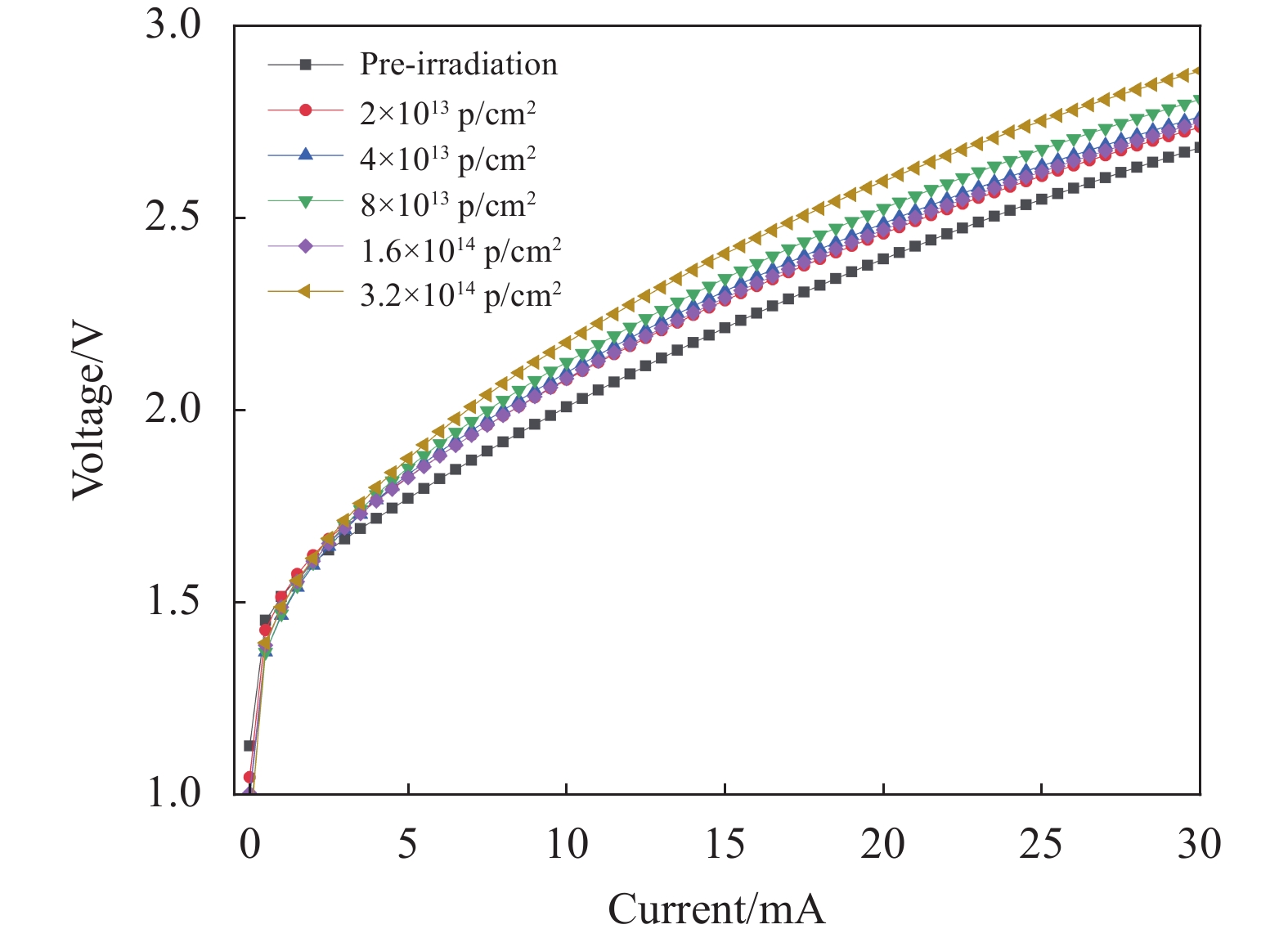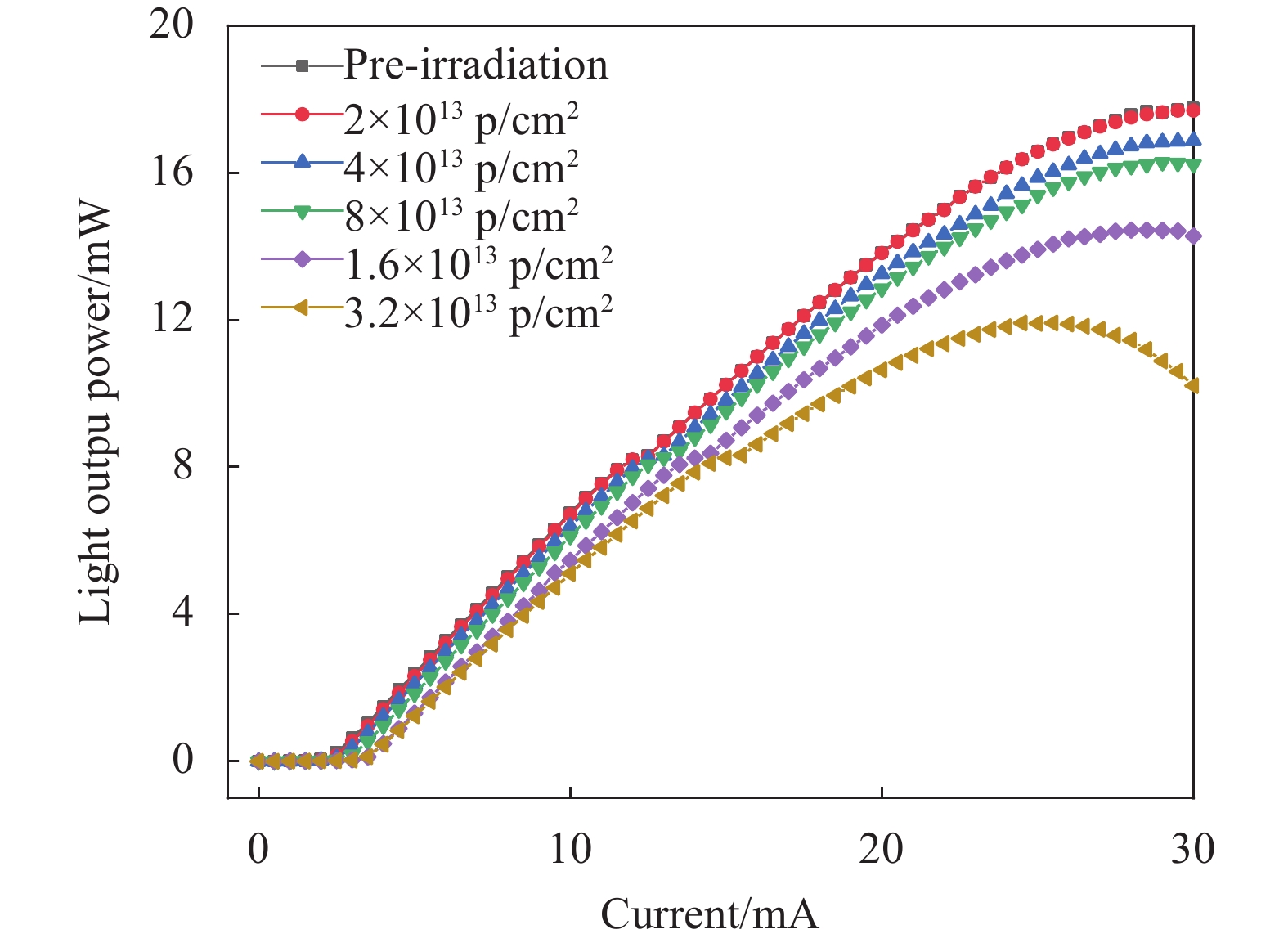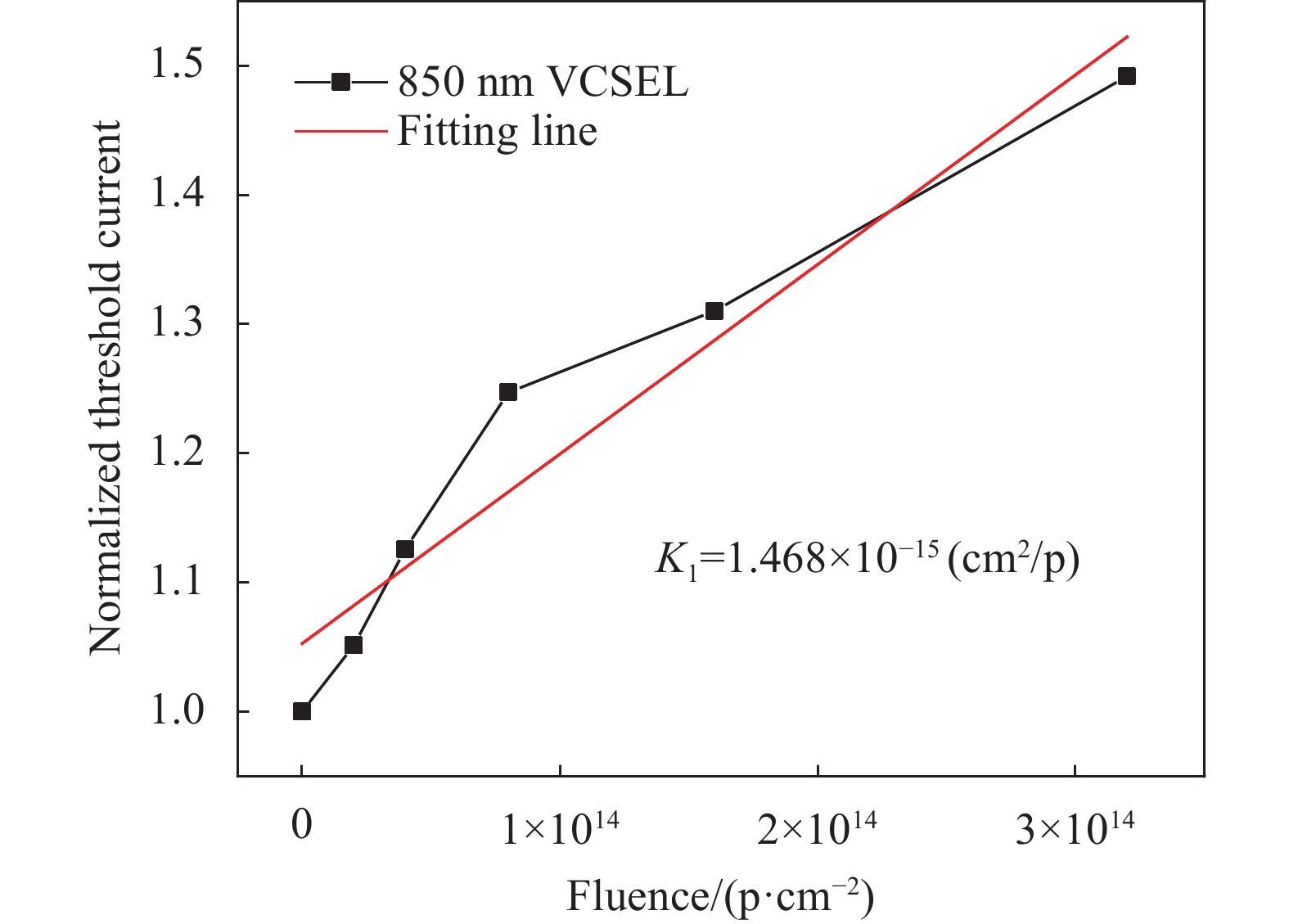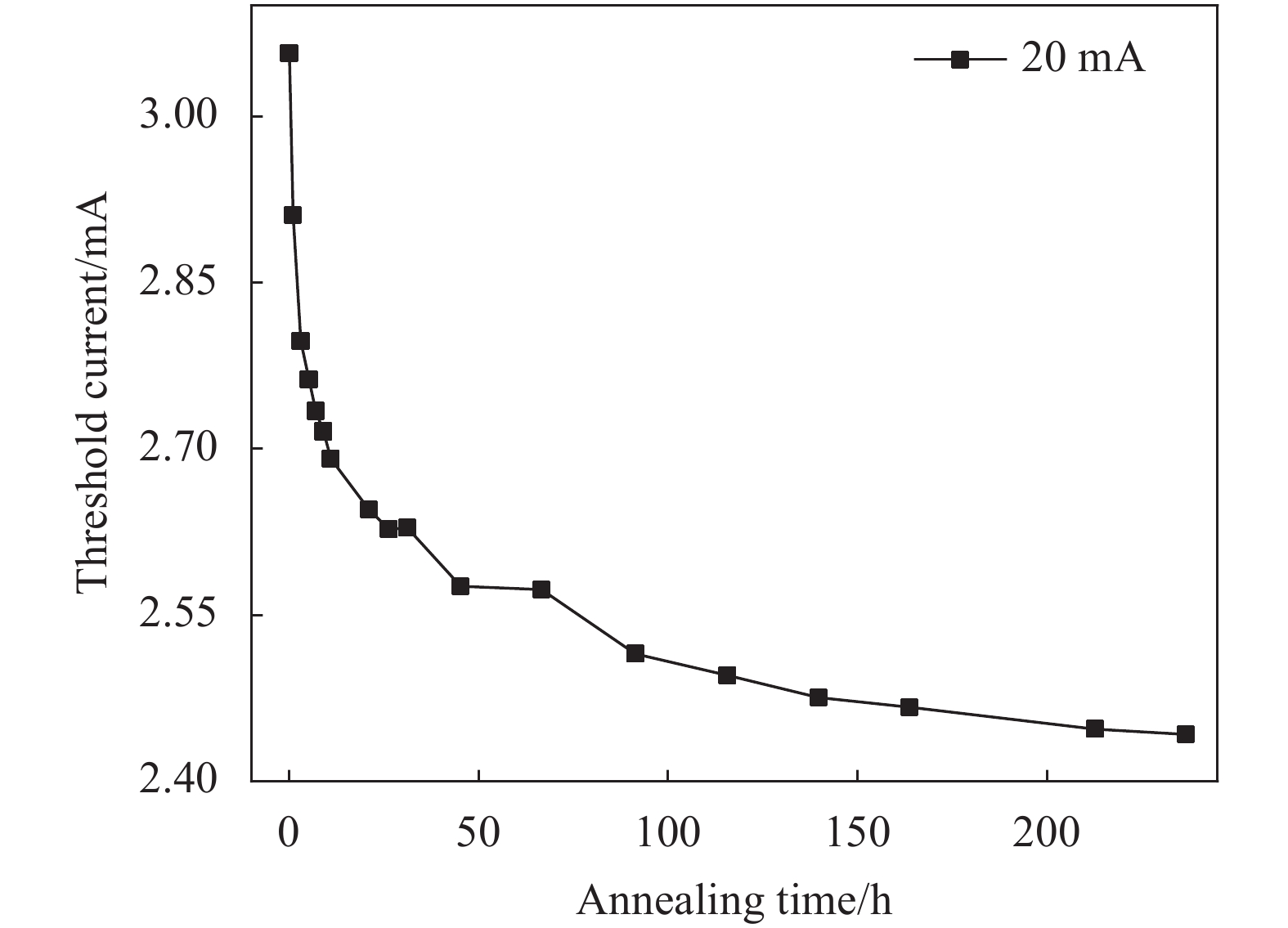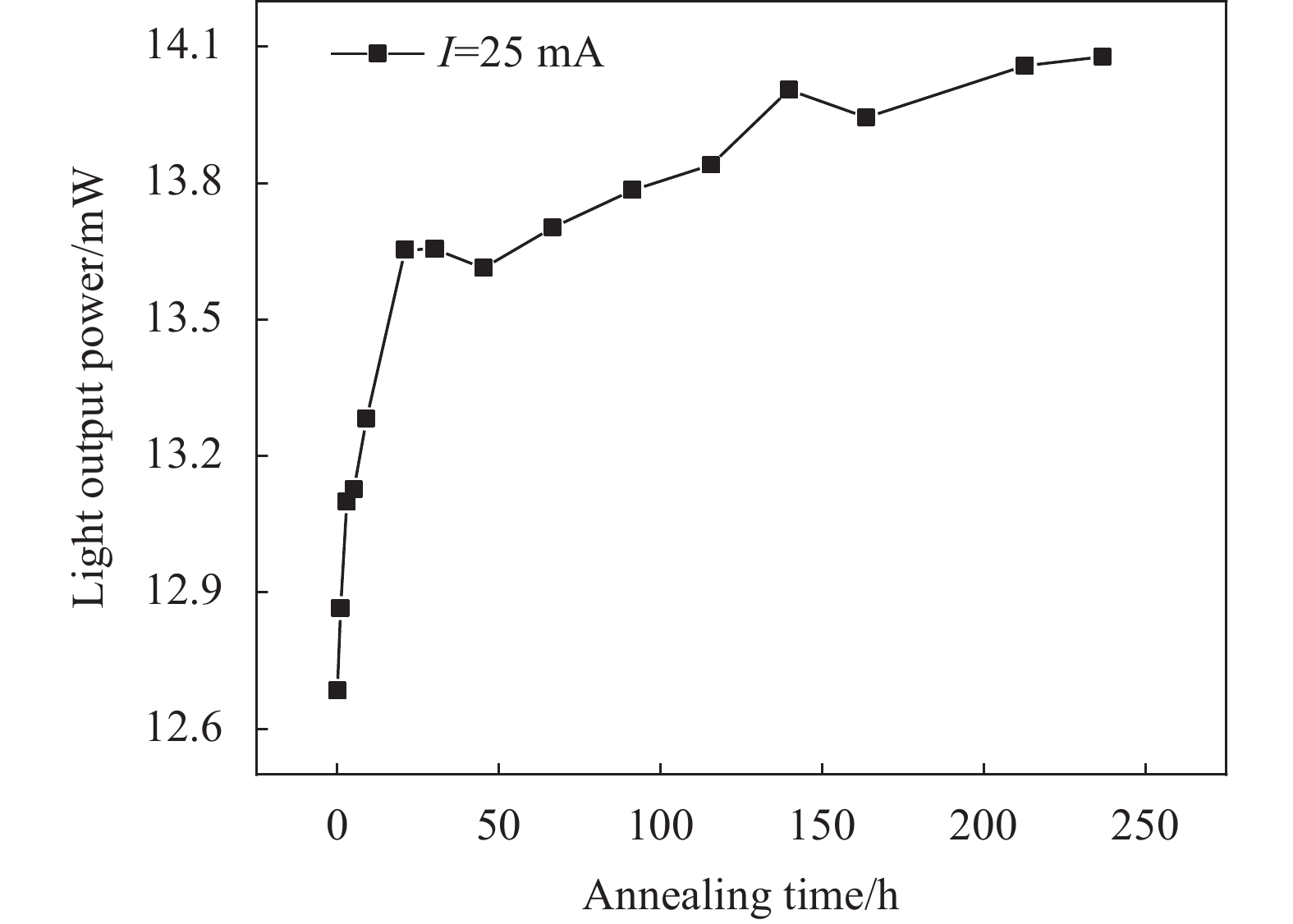-
垂直腔面发射激光器(Vertical-Cavity Surface-Emitting Laser,VCSEL)自量子阱有源区产生激光并在上下分布布拉格反射层(distributed Bragg reflector, DBR)中反射,然后垂直于芯片表面出射激光,这种特殊的结构使其相比于传统边缘发射激光器具有阈值电流低、远场图对称、调制速率快、成本低以及更容易二维集成等优势[1-2]。自20世纪90年代中期以来,基于AlGaAs材料系统的多模850 nm垂直腔面发射激光器一直是基于光纤的数据通信链路的标准光源。此外,使用VCSEL作为核心器件的光互联模块在传输距离、传输速率、功耗上远远领先于传统铜线互联[3]。这使得光互连模块对于空间任务中数据的通信具有巨大吸引力。
然而,脱离了地球大气环境的保护,空间辐射环境中存在大量的电子、质子和重离子等各种高能粒子。这些高能带电粒子与卫星上元器件及材料发生相互作用,产生各种辐射效应[4-5],从而对元器件及卫星上各系统的可靠性提出巨大挑战。因此,了解VCSEL在辐射环境下的退化对于评估光互连模块的可靠性及卫星设计中的应用起到至关重要的作用。
随着工艺及结构的更新,近几年对激光器的研究主要集中在新型的器件,尤其是量子阱激光器、量子点激光器和VCSEL[6-7]。E. W. Taylor等人最早进行了4.5 MeV VCSEL的辐射效应研究,在吸收剂量到达1.19 MGy时,观察到了VCSEL的功率-电流-电压(L-I-V)曲线的退化 [8]。M. Boutillier等人进行了电子辐照852 nm激光器,在质子注量到1016 e/cm2时阈值电流增加5%,并认为这种退化是由非辐射复合中心引起的 [9]。黄绍艳对2 MeV、5 MeV质子对FB腔及分布反馈结构多量子阱激光二极管研究表明激光二极管阈值电流随注量的增大而增加,且2 MeV质子要比5 MeV质子导致的阈值电流增大更多[10]。文中对850 nm VCSEL进行了系统的辐照及退火实验, 结合L-I-V曲线对VCSEL参数的退化机制进行了分析研究。并详细分析了辐照对阈值电流、外量子效率(External Quantum Efficiency, EQE)和光功率等参数退化的物理机制。
-
此次实验采用的样品为Vixar公司的850 nm多模VCSEL,实验样品的扫描透射电镜(Scanning Transmission Electron Microscopy,STEM)结构图如图1所示,在n型GaAs衬底上分别生长n电极,n型DBR,量子阱及包覆层,限制电流注入的氧化层,p型DBR和p电极。在室温下,其最佳工作电流为25 mA,峰值光功率为18 mW。VCSEL使用三个量子阱(Multiple Quantum Wells,MQWs)的结构,该有源区夹在两个AlGaAs包覆层之间。DBR由20.5对p型掺杂顶部反射镜和38.5对n型掺杂底部反射镜在n掺杂的GaAs衬底上生长而成。试验样品采用TO-46形式封装,其封装盖在辐照前被去除以避免对质子能量的影响。辐照时VCSEL处于开路状态并垂直于辐射源。

Figure 1. STEM cross-sectional image of the 850 nm VCSEL; (b) Magnification of the partial structure of AlGaAs/GaAs MQWs
γ-射线辐照实验使用新疆理化技术研究所60Co辐射源,选取剂量点分别为5 Mrad (Si)、10 Mrad(Si)、100 Mrad(Si)。质子辐照实验在北京大学重离子物理研究所2×6 MeV EN 串列静电加速器上进行,质子能量为10 MeV。通过MULASSIS工具进行的计算10 MeV质子能够完全穿透有源器件区域并到达衬底[11]。质子注量点分别为2×1013、4×1013、8×1013、1.6×1014、3.2×1014 p/cm2,注量意为单位面积上辐照引入的质子数量。退火实验选取注入电流为20 mA,退火时间为236 h,每个退火点的测试时间控制在15 min以内。
在辐照及退火后,使用扫描狭缝光束轮廓仪及4200 A-SCS半导体参数分析仪测试了VCSEL的L-I-V曲线。由于VCSEL的光学特性受温度影响较大,测试时使用台式激光二极管/ TEC控制器驱动器件并严格控制测试温度为30 ℃,光功率测试时使用标准VCSEL在最佳工作电流下校准光输出功率。
-
VCSEL在空间辐射环境下产生光电参数退化主要是因为位移损伤的影响[12]。位移损伤效应是当粒子入射到材料上时,一部分晶格原子因为碰撞而离开晶格位置,从而诱导了孤立空位和间隙缺陷、反位缺陷和更复杂的缺陷,由于周期性晶格结构的破坏,这些缺陷在量子阱带隙中引入了新的能级。这些新的能级起到复合载流子的非辐射复合中心作用。
10 MeV质子辐照后VCSEL的I-V特性与注量的关系如图2所示,图中电压电流的比值即为VCSEL的串联电阻,随着驱动电流的增加,由于器件中的载流子浓度和注入电流同时提高,串联电阻会减小。辐照后,随着注量的增加,在给定电流下需要更高的电压来驱动VCSEL,其本质是串联电阻的增加,这归因于辐照引入的非辐射复合中心,载流子的平均漂移速度由于非辐射复合中心的影响而降低,因此电阻率增大,在I-V曲线中表现为曲线向上漂移。
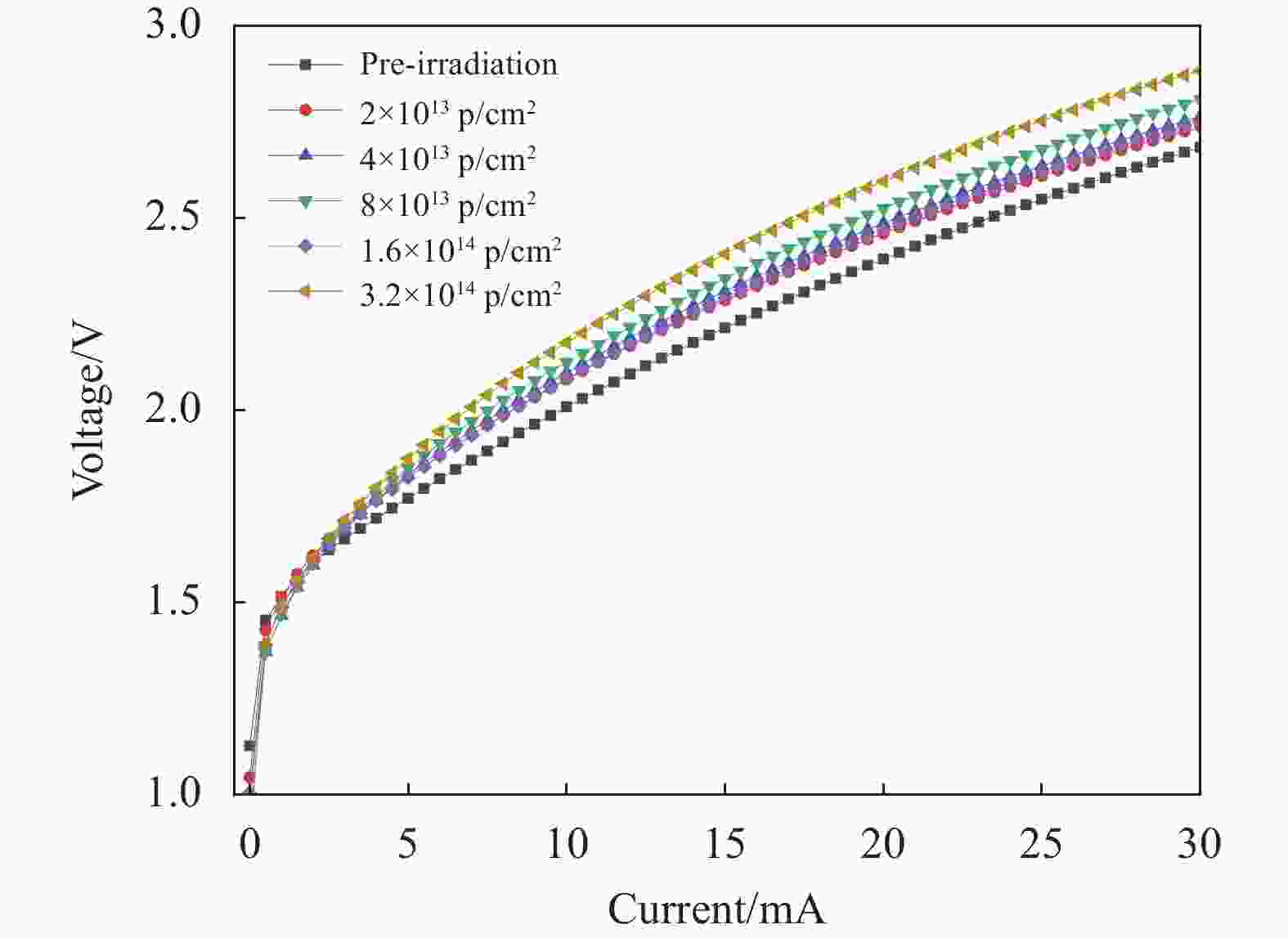
Figure 2. Curve of I-V characteristics with the amount of the injected after 10 MeV proton irradiation
阈值电流定义为VCSEL从荧光模式切换到激光模式时对应的电流,在L-I曲线中,采用两段直线法获得阈值电流,对荧光模式和激光模式的数据进行线性拟合,两条拟合直线的交点对应的横坐标即为阈值电流。从图3可见阈值电流随着质子注量的增大而增大,辐照后阈值电流变为初值的1.492倍。对于VCSEL,由于辐照引入的非辐射复合中心降低了少数载流子寿命,而少子寿命与控制荧光模式和激光模式的自发发射和受激发射直接相关,因此阈值电流增大。使用阈值电流损伤因子可以预测阈值电流的漂移,阈值电流损伤因子表达式如下[13]:
式中:Ith(0)为初始阈值电流;Ith为辐照后阈值电流;Ф为质子注量,单位:p/cm2;K1为阈值电流损伤因子。经过拟合计算,10 MeV质子辐照下VCSEL的阈值电流损伤因子为1.468×10−15 cm2/p,如图4所示。阈值电流损伤因子对于预估VCSEL在高注量下的性能退化具有重要意义,该因子降低了地面评估实验的工作量。
在L-I曲线中,斜率效率定义为VCSEL进入激光模式后线性部分的斜率,该参数表现了VCSEL将载流子转化为光子的能力,斜率效率越大则VCSEL的特性越好,通过斜率效率
$ {\eta }_{d} $ 可以计算EQE,其公式如下[14]:式中:
$ {\eta }_{ex} $ 为EQE;$ {\eta }_{d} $ 为斜率效率;$ \lambda $ 为工作波长;$ h $ 为普朗克常数;$ c $ 为光速。EQE可以更加直观地反应辐照后量子阱部分的退化,EQE随注量的变化计算结果如图5所示,随着质子注量的增加,EQE逐渐降低且呈线性变化,辐照后EQE退化为初值的87.5%。由于辐照引入的非辐射复合中心复合了部分载流子,使得在单位时间内注入有源区电子空穴对数不变的情况下每秒产生的光子数降低,因此,EQE随质子注量的增大而降低。 -
由于质子辐照时会引入电离总剂量效应,为了探究电离总剂量效应对VCSEL性能退化的影响,使用60Co辐射源开展γ射线辐照研究。γ-射线辐照结果如图6所示,从图中可见,γ辐照总剂量达到100 Mrad(Si)后,VCSEL的L-I-V特性曲线没有发生明显的漂移,即VCSEL对总剂量效应不敏感。然而,光输出功率的部分放大图表明,VCSEL的光学特性有先恢复后退化的趋势,即VCSEL的输出特性在一定剂量下获得轻微的改善,如图6中部分放大图所示。这种现象可以解释为晶体中的辐射诱导有序效应,沉积能量能促进量子阱界面附近的晶体有序,从而补偿甚至克服位移损伤的影响,但是其贡献相对较小,所以在一定剂量后又呈现退化的趋势。
-
许多光电器件在施加正向偏压时会出现注入退火现象,即在偏压下器件的光电性能会有所恢复。这种现象用复合增强缺陷反应来解释[15],即缺陷复合速率与注入的电荷密度线性相关,随着注入电流的注入,单位时间内复合的缺陷数量增多,即缺陷复合速率增大。由于缺陷的数量的降低,则阈值电流逐渐恢复。为了探究电注入退火对工作条件下VCSEL的性能影响。图7展示了20 mA注入电流下VCSLE的阈值电流变化,经过236小时退火后,阈值电流恢复了20.1%并趋于稳定。
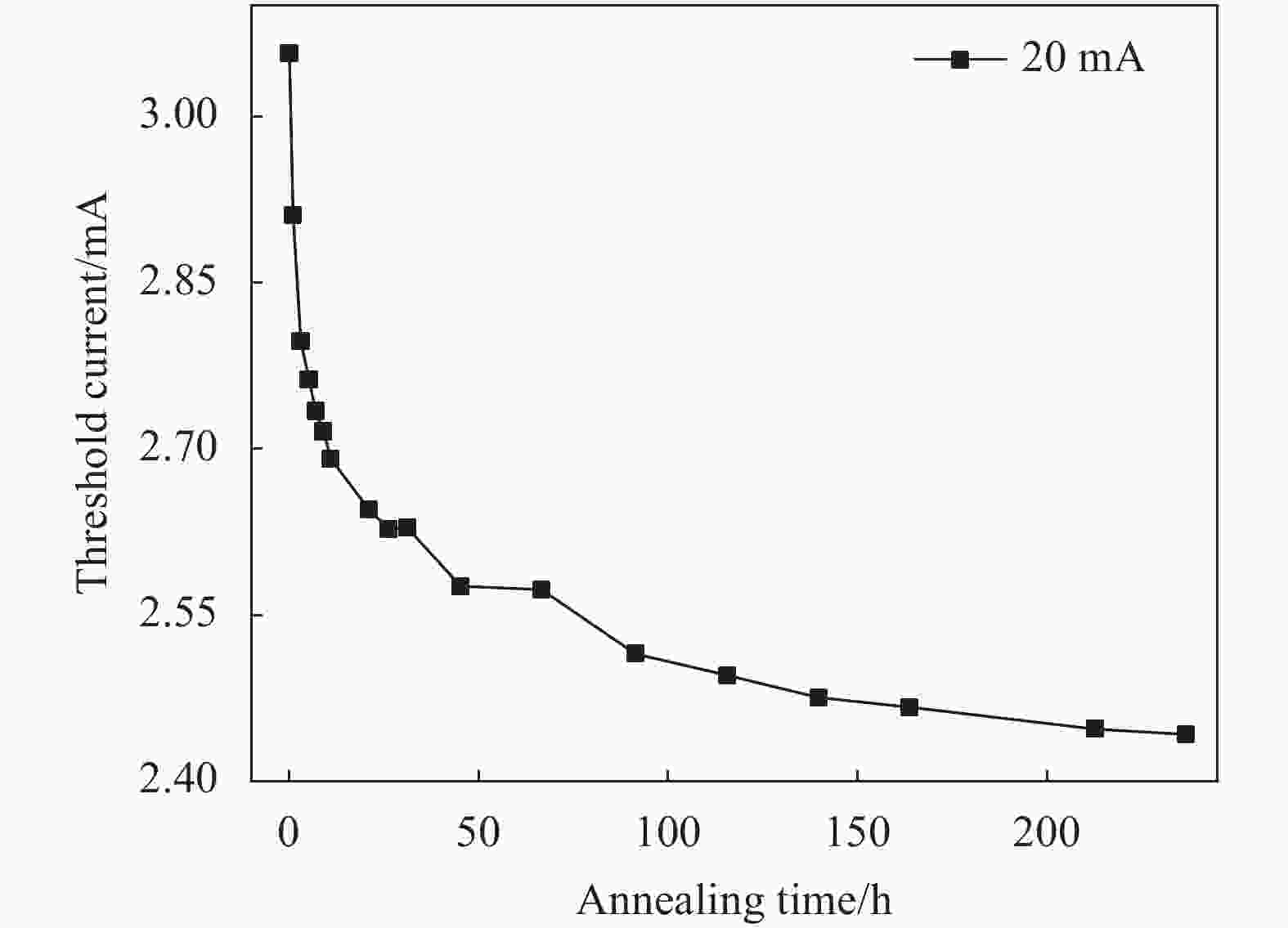
Figure 7. Relationship between threshold current and annealing time of VCSEL under 20 mA current injection
此外,VCSEL在25 mA最佳工作电流驱动下,在236 h退火后其光输出功率恢复了10.0%,如图8所示。光输出功率的恢复主要受两方面的影响:一是由于非辐射复合概率降低,载流子复合产生光子数增多;二是非辐射复合会产生热量使结温升高,当非辐射复合概率降低,则器件结温降低,因此输出光功率增加。VCSEL加电后阈值电流和光输出功率恢复的这一特性对于器件的实际应用具有重要价值,器件在正常加电使用时,注入的电流会使其部分缺陷恢复,所以,其抗辐射性能会比实验评估的结果更加优异。
-
文中研究了γ-射线与10 MeV质子辐照对VCSEL性能退化的影响,研究结果表明,VCSEL对γ-射线引入的总剂量效应不敏感,且在一定范围内辐照会引起VCSEL性能的微小恢复,在质子辐照下,随着质子注量的增加,VCSEL的光输出功率下降,串联电阻增大,阈值电流增大,EQE降低,经过计算,阈值电流损伤因子为1.468×10−15 cm2/p,VCSEL光电参数的退化归因于辐照引入的非辐射复合中心,非辐射复合中心不仅复合载流子,还会产生更多热量。此外,20 mA加电增强退火实验表明,经过退火后,阈值电流与光输出功率均有所恢复,阈值电流与光输出功率在236 h退火后分别恢复了20.1%和10.0%并趋于稳定。文中系统的进行了质子与γ-射线辐射对VCSEL的影响,辐照对VCSEL参数退化的结果对VCSEL及包含VCSEL的光通信系统及光互连模块在恶劣空间辐射环境下的应用具有非常重要的参考价值。
Radiation effect of 850 nm vertical-cavity surface-emitting laser
doi: 10.3788/IRLA20210326
- Received Date: 2021-12-25
- Rev Recd Date: 2022-02-20
- Publish Date: 2022-06-08
-
Key words:
- VCSEL /
- radiation effects /
- displacement damage /
- annealing
Abstract: To explore the degradation and mechanism of 850 nm high-speed vertical-cavity surface-emitting laser in space radiation environment, the degradation of light output power and threshold current were obtained by Gamma ray and 10 MeV proton irradiation. The physical mechanism of VCSEL parameter degradation caused by radiation was analyzed. In addition, 236 h forward-bias annealing research was also carried out. The results show that VCSEL is not sensitive to the total dose effect caused by gamma rays, the photoelectric properties have a certain degree of recovery due to the deposition energy promoting the order of the crystals near the quantum well interface within a certain dose range. But threshold current and external quantum efficiency of VCSEL are degraded in varying degrees under proton irradiation, the threshold current damage factor is calculated to be 1.468 × 10−15 cm2/p. After 20 mA forward-bias annealing, the threshold current is restored by 20%, and the optical output power is restored by 10% at 25 mA injection current. The degradation of threshold current and external quantum efficiency is attributed to the non-radiative recombination center introduced by proton irradiation. These results provide support for the application of VCSEL and the data communication and instrument system containing VCSEL in harsh space radiation environment.






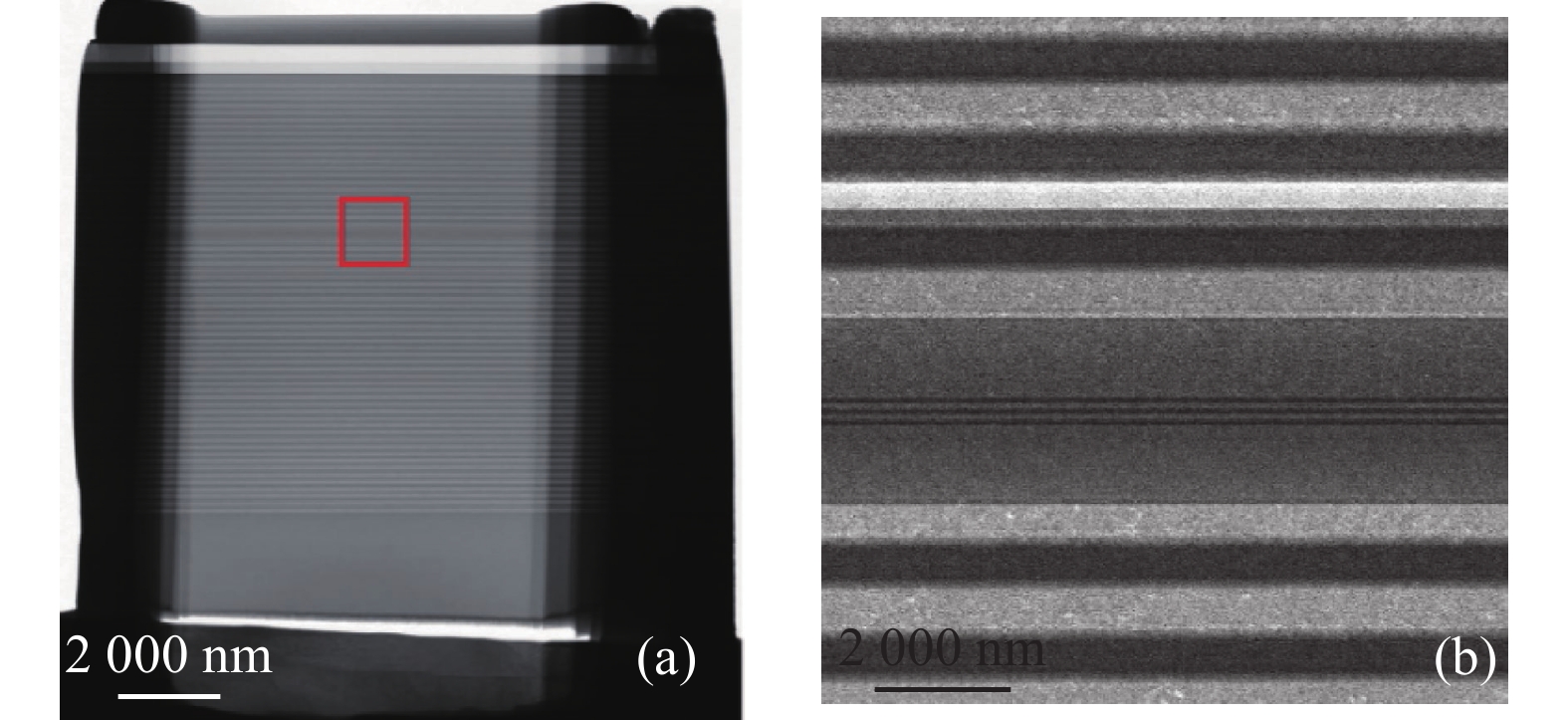


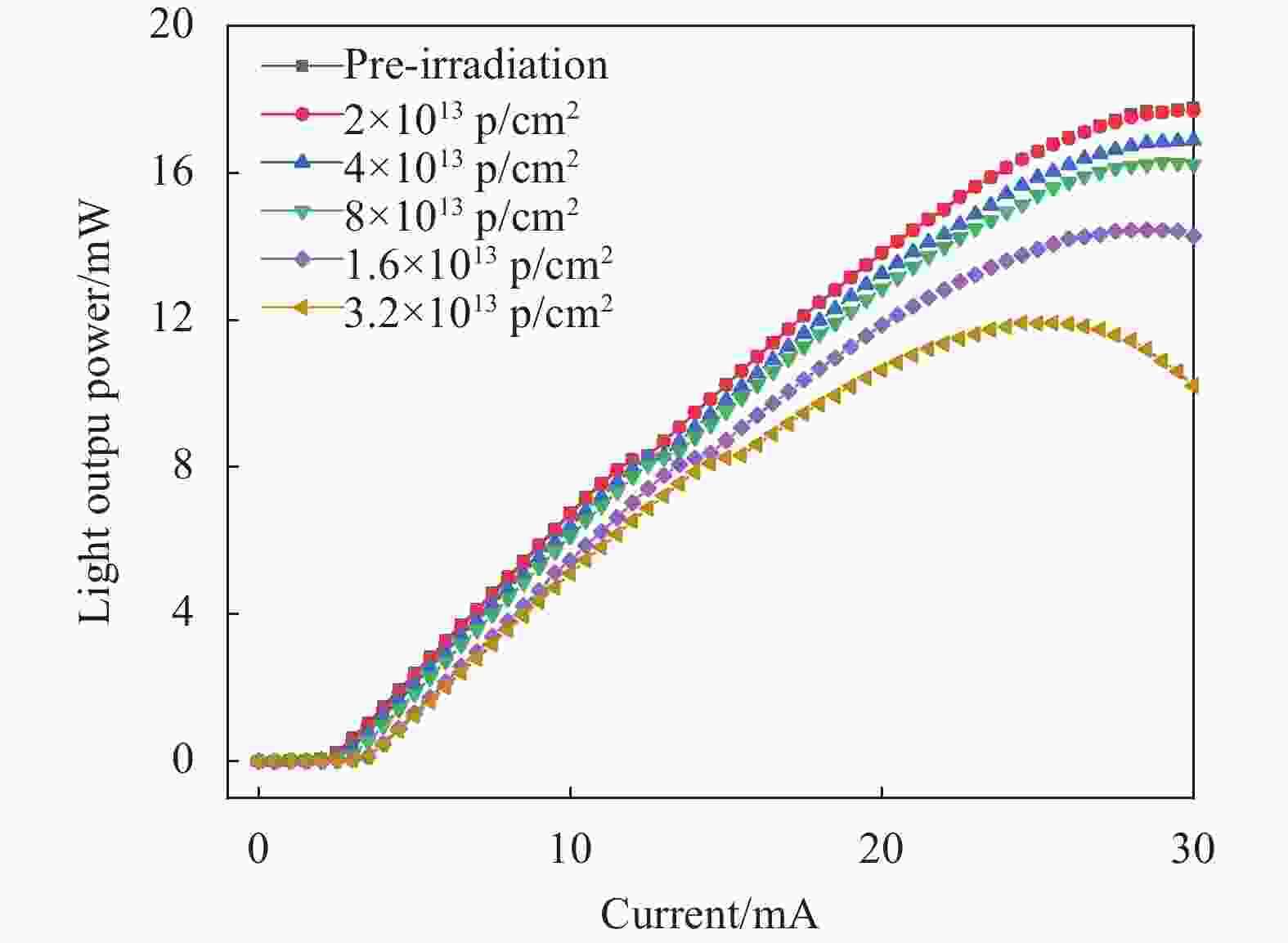
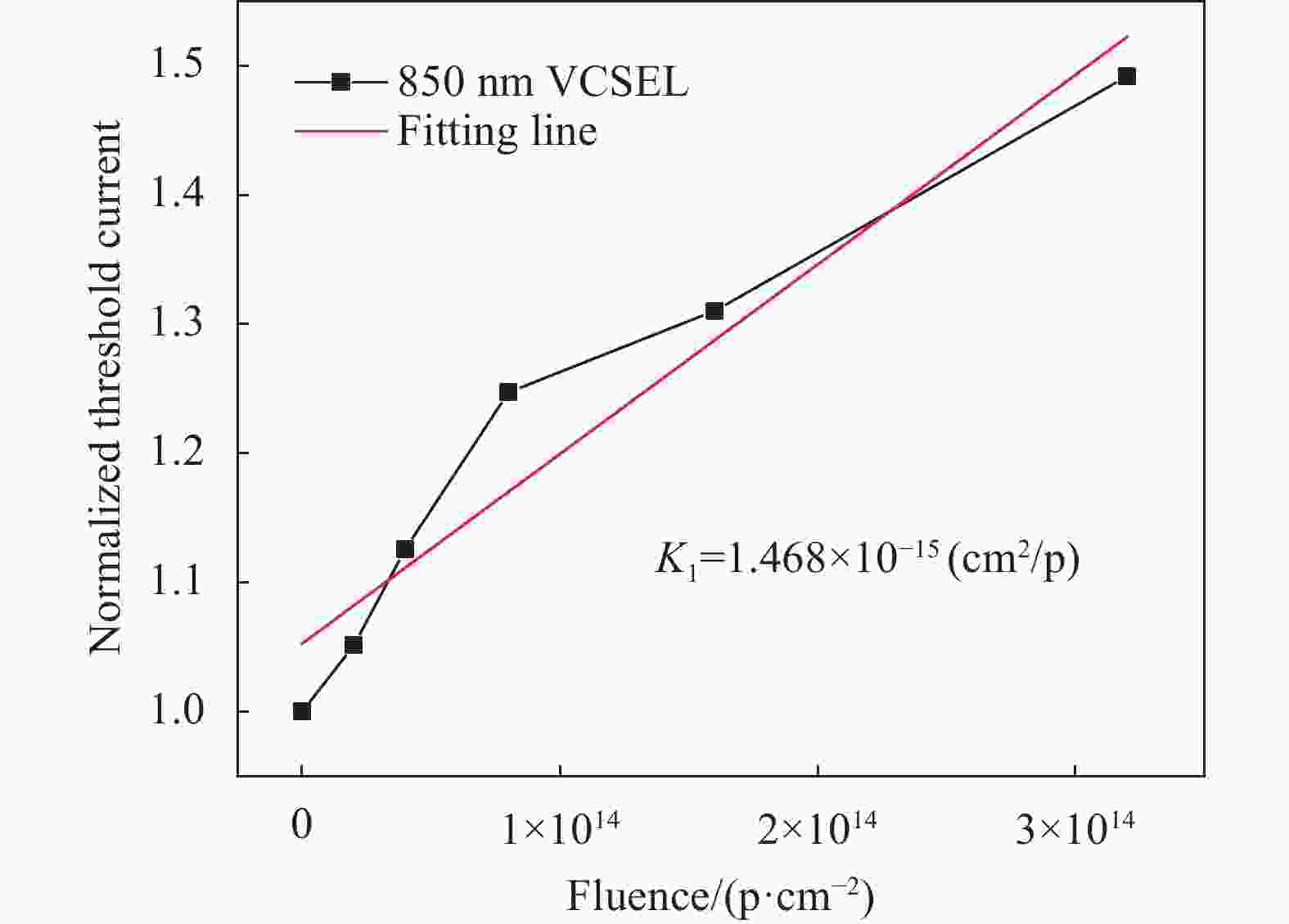










 DownLoad:
DownLoad:
